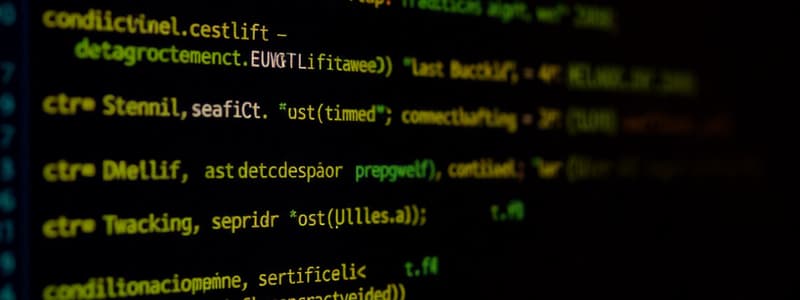Podcast
Questions and Answers
Which characteristic distinguishes pseudocode from actual programming languages?
Which characteristic distinguishes pseudocode from actual programming languages?
- Use of meaningful names for data items.
- Assignment operation using an arrow symbol.
- Use of English-like keywords.
- Absence of strict syntax rules. (correct)
In pseudocode, the symbol '<=' is used to represent 'less than' comparison.
In pseudocode, the symbol '<=' is used to represent 'less than' comparison.
False (B)
What is the purpose of using meaningful names for data items in pseudocode?
What is the purpose of using meaningful names for data items in pseudocode?
To improve readability and understanding of the algorithm
In pseudocode, assignment operations are commonly represented using the ______ symbol.
In pseudocode, assignment operations are commonly represented using the ______ symbol.
Match each pseudocode concept with its corresponding description:
Match each pseudocode concept with its corresponding description:
Flashcards
What is pseudo code?
What is pseudo code?
Using English keywords to represent algorithms.
What type of names are given to data items?
What type of names are given to data items?
Variables and constants.
Is Pseudo code strict?
Is Pseudo code strict?
It is not bound by strict syntax rules.
What does the arrow symbol (<-) do?
What does the arrow symbol (<-) do?
Signup and view all the flashcards
What does '<=' mean?
What does '<=' mean?
Signup and view all the flashcards
Study Notes
Pseudo Code
- Pseudo code uses English keywords to represent algorithms, similar to high-level programming languages like Python.
- Meaningful names are given to data items, like variables and constants in programming.
- It is not bound by strict syntax rules.
- The arrow symbol (<-) is used to assign values to variables or constants, like the equals sign in programming.
Mathematical Operators
- Plus sign (+) is used for addition.
- Minus sign (-) is used for subtraction.
- Star (*) is used for multiplication
- Slash (/) is used for division.
- Up arrow (^) is used to raise to the power.
- Parentheses/brackets () are used to define order of operations.
Conditional Statements: IF
- Conditional statements can be true or false
- Structure: IF condition THEN action ENDIF
- IF variable age < 18 THEN print "child" ELSE print "adult" ENDIF
Conditional Statements: CASE
- Used for choosing items from a list.
- Structure: CASE variable OF option1: action1 option2: action2 OTHERWISE: default action ENDCASE
- Example: CASE grade OF A: print "excellent" B: print "good" C: print "average" OTHERWISE: print "improvement needed" ENDCASE
Comparison Operators
- Greater than (>)
- Less than (<)
- Equal to (=)
- Greater than or equal to (>=)
- Less than or equal to (<=)
- Not equal to (!=)
- AND, OR, NOT for combining conditions
Nested IFs
- An IF statement inside another IF statement.
Loops: FOR Loop
- Use "FOR" to repeat an action a specific number of times
- Example: FOR counter <- 1 TO 10 DO output star NEXT counter (prints 10 stars)
Loops: REPEAT UNTIL Loop
- "REPEAT" an action UNTIL a condition is met
- Example:
- counter <- 0
- REPEAT output star
- counter <- counter + 1
- UNTIL counter > 9
Loops: WHILE Loop
- "WHILE" a condition is true, DO an action
- Example:
- counter <- 0
- WHILE counter < 10 DO
- output star counter <- counter + 1
- ENDWHILE
- Can have preconditioned loops (test at the beginning) or post-conditioned loops.
Input and Output
- OUTPUT displays a message on the screen.
- INPUT gets a value from the user.
Editors
- Sample pseudo code can be tested using online editors.
Studying That Suits You
Use AI to generate personalized quizzes and flashcards to suit your learning preferences.




